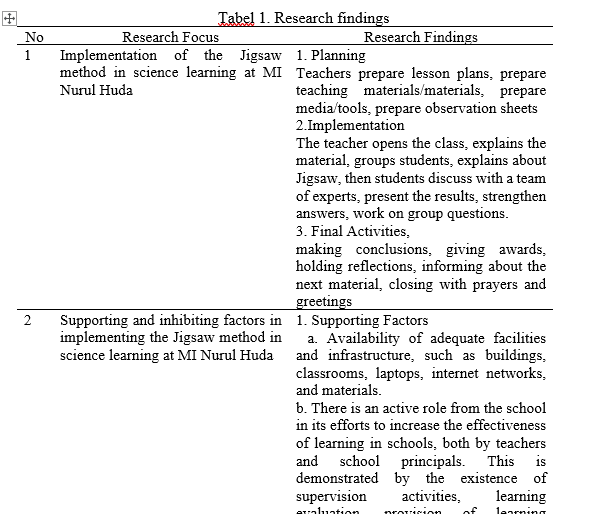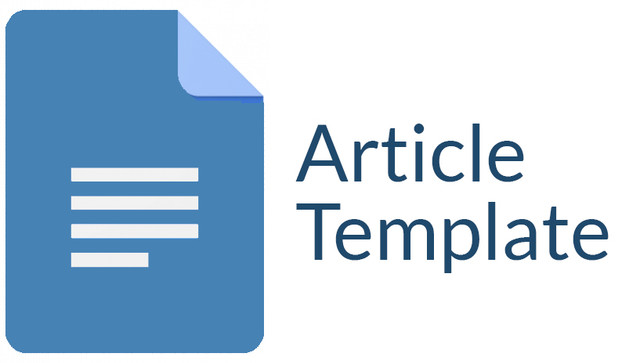Supporting and Inhibiting Factors In The Application of The Jigsaw Method In Class V Science Subjects In Elementary School
DOI:
https://doi.org/10.30736/seaj.v6i1.1032Keywords:
supporting factors, obstacle factor, jigsaw methodAbstract
This research describes the supporting and inhibiting factors in implementing the Jigsaw method in science learning for class V elementary schools. The type of research used is a case study with a descriptive qualitative approach. Data collection techniques are interviews, observation and documentation. Miles and Huberman model data analysis techniques which include data reduction, data presentation, and data verification. The results of the research show that the supporting factors are the fulfillment of school facilities and infrastructure, as well as the active role of the school, both by teachers and school principals through programs that are able to increase teacher competence in relation to learning at school and the inhibiting factor is that the jigsaw method requires a long time. old and smart students tend not to want to be put together. The application of the jigsaw method in grade V elementary school science learning begins with the preparation of learning tools such as lesson plans. The teacher carries out the implementation process in learning, including initial or opening activities, core activities and final activities. The initial activities were carried out by the teacher by providing motivation and apperception. In the core activity, the teacher implements the Jigsaw method through the steps that have been prepared. In the final activity, the teacher provides a conclusion. The evaluation process is carried out through written tests. The results show effectiveness in the learning process and are able to improve learning outcomes for student.
Downloads
References
Alfiana, A., & Fathoni, A. (2022). Kesulitan Guru dalam Menerapkan Pembelajaran IPA Berbasis Etnosains di Sekolah Dasar. Jurnal Basicedu, 6(4), 5721–5727. https://doi.org/10.31004/basicedu.v6i4.3123
Ariawan, R., & Putri, K. J. (2020). Pengembangan Perangkat Pembelajaran Matematika dengan Model Pembelajaran Problem Based Learning Disertai Pendekatan Visual Thinking Pada Pokok Bahasan Kubus dan Balok Kelas VIII. JURING (Journal for Research in Mathematics Learning), 3(3), 293. https://doi.org/10.24014/juring.v3i3.10558
Daniel, B. K., & Harland, T. (2017). Higher Education Research Methodology. Higher Education Research Methodology. https://doi.org/10.4324/9781315149783
Fatimah, A. T., Amam, A., & Effendi, A. (2017). Konstruksi Pengetahuan Trigonometri Kelas X Melalui Geogebra dan LKPD. JNPM (Jurnal Nasional Pendidikan Matematika), 1(2), 178. https://doi.org/10.33603/jnpm.v1i2.596
Fatmawati, Sholahuddin, A., & Sari, M. M. (2021). Bahan Ajar IPA SMP Berbasis Literasi Sains dan Kearifan Lokal Lahan Basah Pada Materi Tanah dan Keberlangsungan Kehidupan. Jurnal Pendidikan Sains Dan Terapan (JPST), 1(1), 77–88.
Heri, H., Saam, Z., & Isjoni, I. (2019). Pengelolaan Program Ekstrakurikuler Di Sekolah Dasar Negeri 005 Binuang Kecamatan Bangkinang Kabupaten Kampar. Jurnal Manajemen Pendidikan Penelitian Kualitatif, 3(1), 18. https://doi.org/10.31258/jmppk.3.1.p.18-24
HS Sudarto, Y. S. (2014). Prestasi Belajar Mata Pelajaran Ekonomi Kelas Unggulan Ditinjau Dari Aspek Pemilihan, Motivasi Belajar Dan Sarana Penunjang Pembelajaran. Jurnal Pendidikan Ilmu Sosial, 24(1), 55–66. journals.ums.ac.id/index.php/jpis/article/download/829/552
Jumrawarsi, J., & Suhaili, N. (2021). Peran Seorang Guru Dalam Menciptakan Lingkungan Belajar Yang Kondusif. Ensiklopedia Education Review, 2(3), 50–54. https://doi.org/10.33559/eer.v2i3.628
Kusuma, A. W. (2018). Meningkatkan Kerjasama Siswa dengan Metode Jigsaw. Konselor, 7(1), 26–30. https://doi.org/10.24036/02018718458-0-00
Miski, R. (2015). Pengaruh Sarana dan Prasarana terhadap Hasil Belajar Siswa. Tadbir Muwahhid, 4(2), 69–73.
Nasution, M. K. (2017). Penggunaan metode pembelajaran dalam peningkatan hasil belajar siswa. STUDIA DIDAKTIKA: Jurnal Ilmiah Bidang Pendidikan, 11(1), 9–16.
Nugroho, P. S., Khasanah, S. R. U., Jannah, A. M., Yolanda, V., Suhendra, H., & Rahmad, M. (2022). Intensitas Pemanfaatan Laboratorium IPA Fisika di SMP Pasca Pandemi Covid-1. Edukatif : Jurnal Ilmu Pendidikan, 4(3), 3248–3254. https://doi.org/10.31004/edukatif.v4i3.2387
Nurdyansyah, & Mutala’liah, N. (2018). Pengembangan Bahan Ajar Modul Ilmu Pengetahuan Alambagi Siswa Kelas IV Sekolah Dasar. Program Studi Pendidikan Guru Madrasa Ibtida’iyah Fakultas Agama Islam Universitas Muhammadiyah Sidoarjo, 41(20), 1–15.
Nurmalasari, Y., & Erdiantoro, R. (2020). Perencanaan Dan Keputusan Karier: Konsep Krusial Dalam Layanan BK Karier. Quanta, 4(1), 44–51. https://doi.org/10.22460/q.v1i1p1-10.497
Purnamasari, A., & Afriansyah, E. A. (2021). Kemampuan Komunikasi Matematis Siswa SMP pada Topik Penyajian Data di Pondok Pesantren. Plusminus: Jurnal Pendidikan Matematika, 1(2), 207–222. https://doi.org/10.31980/plusminus.v1i2.1257
Puspasari, A., Susilowati, I., Kurniawati, L., Utami, R. R., Gunawan, I., & Sayekti, I. C. (2019). Implementasi Etnosains dalam Pembelajaran IPA di SD Muhammadiyah Alam Surya Mentari Surakarta. SEJ (Science Education Journal), 3(1), 25–31. https://doi.org/10.21070/sej.v3i1.2426
Riyanti, R. (2020). Efektivitas Penggunaan Perangkat Pembelajaran Project Based Learning (PjBL) Terintegrasi STEM Berbasis E-Learning Untuk meningkatkan Kemampuan Berpikir Kreatif. DWIJA CENDEKIA: Jurnal Riset Pedagogik, 4(2), 206. https://doi.org/10.20961/jdc.v4i2.45276
Septaria, K., & Rismayanti, R. (2022). The effect of scientific approach on Junior High school students’ Scientific Creativity and Cognitive Learning Outcomes. Jurnal Penelitian dan Pengkajian Ilmu Pendidikan: e-Saintika, 6(3), 173-189.
Septaria, K., Nissak, K., & Wulandari, S. A. (2023). Student Identity and Guided Inquiry Learning in Junior High School Students: A Correlation Analysis. Jurnal Penelitian Pendidikan IPA, 9(10), 8351-8358
Nurika, L., Septaria, K., & Setyaningsih, S. (2024). Implementing Science Creativity In Junior High School Students Using A Pirporsal Learning Model On Energy Resources. INKUIRI: Jurnal Pendidikan IPA, 13(1), 36-41.
Septaria, K., Fatharani, A., Dewanti, B. A., & Utami, Z. R. (2024). Satuan Pendidikan Aman Bencana (SPAB) Berbasis Partisipatory Rural Appraisal di Madrasah Aliyah Sunan Santri Lamongan. TAAWUN, 4(02), 229-240.
Sri Astiti, D. K., & Murda, I. N. (2017). Penerapan Metode Pembelajaran Jigsaw Sebagai Upaya Meningkatkan Hasil Belajar Ipa Pada Siswa Kelas Iv Sd. Journal of Education Action Research, 1(2), 94. https://doi.org/10.23887/jear.v1i2.12043
Surono, E. T., Kristin, F., & Anugraheni, I. (2019). Penerapan Model Pembeljaran Project Based Learning Untuk Meningkatkan Kreativitas Dan Hasil Belajar Siswa Pada Pembelajaran Tematik Tema 9 Sub Tema 1 Kekayaan Sumber Energi Indonesia Kelas 4 SD Negeri Patemon 01. Pendidikan Tambusai, 3(3), 780–789.
Suryanita SP, N. P., & Kusmariyatni, N. N. (2019). Penerapan Model Pembelajaran Kooperatif Jigsaw Untuk Meningkatkan Hasil Belajar Ips. Jurnal Ilmiah Pendidikan Profesi Guru, 2(3), 258–269. https://doi.org/10.23887/jippg.v2i3.14282
Tri Satyawati, S., Yari Dwikurnaningsih, Bambang Ismanto, Ade Iriani, Marinu Waruwu, & Wasitohadi. (2022). The Meningkatkan Kemampuan Implementasi Merdeka Belajar Melalui Seminar Online Bagi Guru dan Kepala Sekolah. Dinamisia : Jurnal Pengabdian Kepada Masyarakat, 6(2), 353–363. https://doi.org/10.31849/dinamisia.v6i2.8103
Turmuzi, M., Sudiarta, I. G. P., & Suharta, I. G. P. (2022). Systematic Literature Review: Etnomatematika Kearifan Lokal Budaya Sasak. Jurnal Cendekia : Jurnal Pendidikan Matematika, 6(1), 397–413. https://doi.org/10.31004/cendekia.v6i1.1183
Ulwiyah, N., & Mumayizah, N. (2020). Implementasi Metode Jigsaw dan Media Diorama Kelapa untuk Meningkatkan Hasil Belajar Siswa MI pada Mata Pelajaran Tematik. JPDI: Jurnal Pendidikan Dasar Islam, 2(1), 63–78. journal.unipdu.ac.id/index.php/JPDI/index
Winarni, D. S. (2017). Analisis Kesulitan Guru Paud dalam Membelajarakan IPA pada Anak Usia Dini. EduSains: Jurnal Pendidikan Sains & Matematika, 5(1), 12–22.
Yanmi, A. C., & Wasitohadi, W. (2019). Peningkatan hasil belajar tematik menggunakan model kooperatif STAD peserta didik kelas 1 SD. Jurnal Riset Teknologi Dan Inovasi …, 2(1), 38–44.
Yestiani, D. K., & Zahwa, N. (2020). Peran Guru dalam Pembelajaran pada Siswa Sekolah Dasar. Fondatia, 4(1), 41–47. https://doi.org/10.36088/fondatia.v4i1.515

Downloads
Published
How to Cite
Issue
Section
License
Copyright (c) 2024 Hendi Susanto Hendi, Heny Sulistyaningrum

This work is licensed under a Creative Commons Attribution-ShareAlike 4.0 International License.
Authors who publish with this journal agree to the following terms:
- Authors retain copyright and grant the journal right of first publication with the work simultaneously licensed under a Creative Commons Attribution-ShareAlike 4.0 International License that allows others to share the work with an acknowledgment of the work's authorship and initial publication in this journal.
- Authors are able to enter into separate, additional contractual arrangements for the non-exclusive distribution of the journal's published version of the work (e.g., post it to an institutional repository or publish it in a book), with an acknowledgment of its initial publication in this journal.
- Authors are permitted and encouraged to post their work online (e.g., in institutional repositories or on their website) prior to and during the submission process, as it can lead to productive exchanges, as well as earlier and greater citation of published work (See The Effect of Open Access).

This work is licensed under a Creative Commons Attribution-ShareAlike 4.0 International License.









